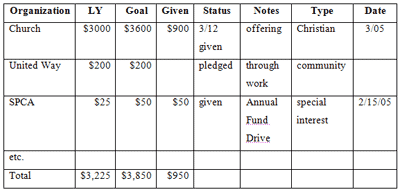Straight from the Heart: A Plan to Organize Your Giving
- Beth Huber Contributing Writer
- Updated Sep 13, 2013

In his book Generous Living, financial expert Ron Blue makes this bold statement: "If I could boil down everything I have ever learned into one sentence or thought, it would be this: Generosity and financial freedom are inextricably linked." He goes on to say, "The folks who enjoy genuine freedom and joy are those who give the most, relative to their incomes."
Most of us do have a heart to give but often find that there isn’t any extra money left over after taking care of bills and other immediate needs. The truth is, no matter how good our intentions are they won’t translate into reality if our approach to giving is haphazard. But with a little organization – and a Giving Plan – you could be giving more than you ever thought possible.
A Giving Plan incorporates your unique vision, enables you to set and evaluate giving goals, helps you monitor your progress, and provides a handy record so you get credit for all your donations when tax time rolls around.
1. Establish your giving goal. This is the amount of money you intend to earmark for giving. Build this number into your annual budget if you have one. Make it a realistic target that you feel certain you can reach. A common figure is 10% of annual income. If that isn’t possible, start smaller and increase the amount over time.
2. Select the recipients of your giving. This step is the heart of the Giving Plan because it involves your passions and values. Identify the causes and organizations you’d like to support: your church, Christian ministries, community charities, medical research efforts, arts organizations, relief funds. As you become more purposeful with your giving, you will begin to notice needs that align with your interests. Leave a small chunk of your goal unbudgeted and you will have the freedom to respond to unanticipated giving opportunities.
3. Create a Giving Plan chart. The chart functions as the skeleton of the plan, giving it structure. In the first column, list the organizations you have decided to support. Create headings for the following columns: LY (Last Year), Goal, Given, Status, Notes, Type, Date. Your layout should end up looking something like this (without the sample data):
The first year that you keep the chart, the LY (Last Year) column will be empty. The Goal column will list the amount you have targeted for each recipient. The Notes column is for details you want to remember about the gift. Each time you make a donation, note it in the Given column and enter the Date. The Status column lets you see at a glance where you stand with each goal. The Type column shows you where your support is going by category: Christian, community, special interest, etc.
4. Create a file for your giving records. Keep all your paperwork in one place. Include a printout of the Giving Plan chart, solicitations from organizations you plan to support or want to consider, and the receipts you will need to document your gifts for tax purposes.
5. Review your Giving Plan on a monthly basis. This step serves as the muscle of the Giving Plan, pushing you toward your giving goals. You may find it helpful to take your annual goal and divide it by twelve to establish a monthly goal. The best approach is to do your monthly giving first, then set aside your savings, and after that start spending the remainder. Making your planned gifts each month will affect your perspective towards money and reinforce giving as a priority.
6. Finalize your Giving Plan in December and revise it for the new year. In early December, check your status on the giving chart so you can take final steps to fulfill your goals. At the end of the year, update your Giving Plan. Re-save the document under a different name, transfer this year’s final totals to the LY (Last Year) column, and delete the other data. Take some time to carefully and prayerfully evaluate your commitments, and establish your goals for the coming year.
As in any other money-management endeavor, good planning will help you achieve your giving goals. A thoughtfully prepared Giving Plan will help you to become more strategic and organized. But let your giving come straight from the heart. As we share our blessings with others, we develop a spirit of generosity that allows us to delight in our financial progress – not just for the ways that it benefits us, but for the ways we can use it to benefit others.
Beth Huber is a pianist, piano teacher and freelance writer. Her work has appeared in such national publications as The Dollar Stretcher, Writer's Digest, The Secret Place and Clavier Magazine. She lives in Chester County, PA. She can be reached at bethhuber@verizon.net.





















